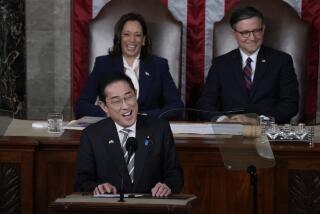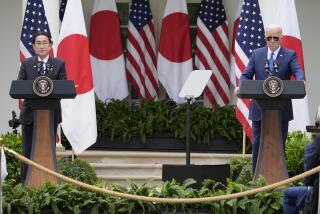NEWS ANALYSIS : Japan Debates Helping U.S. to Rebuild
- Share via
TOKYO — Should Prime Minister Kiichi Miyazawa offer to use Japanese foreign aid to help President Clinton rebuild America?
That question is the subject of an intense debate in Japanese government circles these days as officials prepare for the first meeting of the two leaders in Washington next week.
In what could be a kind of test balloon, the government Export-Import Bank of Japan will announce today its decision to help finance the building of a coal-loading terminal in Los Angeles harbor.
The terminal, for handling coal shipments to Japan, is to be built by Mitsui & Co. and several other Japanese firms. But since it involves low-cost government financing, the deal will represent a form of Japanese aid to the region.
The aid proposal is part of an effort, undertaken on Miyazawa’s orders, to find a more effective way to recycle the huge trade surpluses that Japan is piling up with the rest of the world.
Last year, Japan’s global trade surplus amounted to $133 billion. This year, it is expected to be a slightly smaller $125 billion.
In the past, Japan has partly recycled its surpluses by buying American bonds and real estate and building factories overseas. With Japanese companies in weak financial condition, however, most companies are using what money they have to pay off their debts. Although that results in a flow of capital overseas, it does not produce visible economic activity.
To help recycle all that money more productively and in a manner more likely to win recognition for Japan, the government has put together a plan to spend $70 billion to $75 billion on foreign aid from 1993 to 1997. That would be as much as a 50% increase over the $50 billion spent in the previous five-year period and substantially more than America’s foreign aid bill.
In addition, the government is expected to make about $45 billion in subsidized loans available to foreign countries and businesses through a variety of quasi-government organizations such as the Export-Import Bank.
In the past, virtually all of that money has gone to developing countries. But some officials complain that Japan has not received sufficient credit for its aid efforts, and others suggest that Japan is not truly recycling its cash unless some goes to the United States, which accounts for 40% of Japan’s surplus.
One effort under way has been to use more of the aid money to buy American equipment and services for use in developing countries. That effort is less controversial, although progress is slow.
Another suggestion from the Foreign Ministry and the Ministry of International Trade and Industry is to use government money to offer low-interest loans to help finance such infrastructure projects in the United States as roads and railways.
Domestic critics of the aid plan worry that America will be offended by what might be perceived to be an offer of charity.
Officials at the Ministry of Finance and the Bank of Japan also suggest that it is inappropriate for America to be receiving foreign aid.
If approved, Japan’s aid plan would be part of a larger package of measures that Miyazawa will present to Clinton. Among the measures are expected to be a $120-billion package to boost imports by stimulating the Japanese economy; a joint initiative on tackling environmental problems of the world; joint work on a magnetic levitation train system, and an increase in the number of American students invited to study in Japan.
More to Read
Sign up for Essential California
The most important California stories and recommendations in your inbox every morning.
You may occasionally receive promotional content from the Los Angeles Times.













